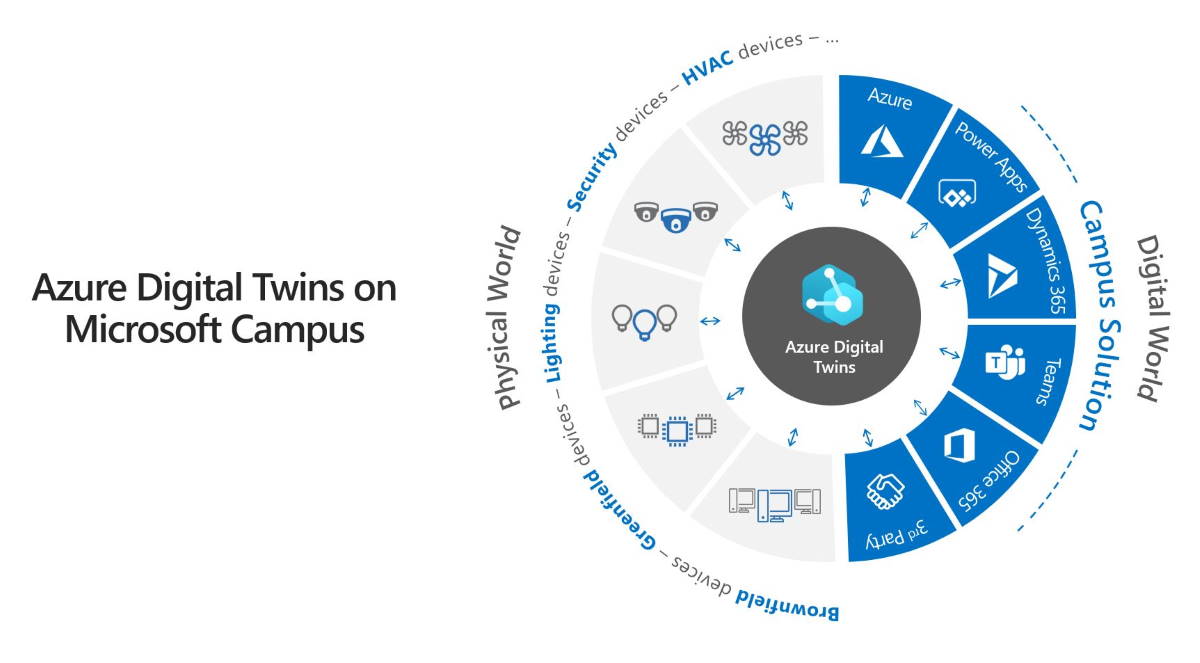 Editor’s note: We’ve republished this blog with a new companion video.
Editor’s note: We’ve republished this blog with a new companion video.
If Microsoft smart buildings had brains, what would they do with them?
Maybe they would perfectly heat and cool themselves, sending energy to the right places at the right times. Maybe they would greet visitors and help them find their way, boosting their productivity by getting them to a meeting more quickly or boosting their blood sugar level by helping them find the nearest on-campus eatery. Maybe they would breathe oxygen into stuffy conference rooms.
These are exactly the kinds of things Microsoft smart buildings will soon be able to do, something that will be on display when the company begins opening its new buildings at its Puget Sound headquarters in late 2023.
The transformation of Microsoft smart buildings is being powered by Microsoft Azure Digital Twins, a platform that enables developers to create digital replicas of physical environments in real time.
It was the time to ask ourselves, “what is the future of work at Microsoft, and how do the spaces we work in help make it amazing?”
– Bill O’Brien, principal PM manager, Microsoft Digital
Launched to public preview in 2018 and to general availability in 2020, Azure Digital Twins is a key smart buildings enabler. It’s a centerpiece of a Microsoft smart buildings pilot that launched in one Puget Sound building in January 2021 as part of the larger campus modernization project. This multi-year renovation project aims to create a world-class work environment with low environmental impact.
Microsoft’s real estate team has partnered with Microsoft Digital and the Microsoft Azure product group to make the new Microsoft smart buildings more intelligent from the perspectives of both employee usage and facilities management.

“Microsoft knew it was making a big investment in a major new campus development and that it would roll out worldwide,” says Bill O’Brien, principal PM manager at Microsoft Digital, the organization that powers, protects, and transforms Microsoft. “It was the time to ask ourselves, ‘what is the future of work at Microsoft, and how do the spaces we work in help make it amazing?’”
The real estate team is using Internet of Things (IoT) connected devices with Azure Digital Twins to integrate inputs from previously siloed data sources such as motion and occupancy sensors to evolve the way Microsoft employees interact with their spaces, with a focus on efficiency and productivity.
In addition to enhancing the employee experience, insights yielded from Azure Digital Twins integrations have helped these partnered teams at Microsoft in multiple aspects of the campus project, from day-to-day operations to future real estate planning.
[Learn more about how Microsoft is creating the digital workplace. Find out how Microsoft uses machine learning to develop smart energy solutions.]
Synchronization between brain and body
Throughout the journey to give a building a brain and bring it to life in a physical body, the team has encountered the interdependencies of any complex organism.
“A building project and a software project are very different,” O’Brien says. “In software, we have very agile development and we can easily move things around. You can’t do that with buildings.”
Effectively aligning software development timelines to construction milestones proved key to the process.

Eric Slippern, the principal software architect for the campus modernization project for Microsoft Digital, says the team also overcame challenges in integrating myriad third-party IoT devices, from heating, ventilation, and cooling (HVAC) systems and elevators to lighting and security, into a single system that could integrate with services and solutions such as Microsoft Azure Maps, Microsoft Power BI, and Microsoft Dynamics 365.
“Azure Digital Twins allows us to integrate IoT sensor telemetry from tens of thousands of devices across the globe,” Slippern says. “We can easily understand the enterprise context of these signals and aggregate them at a floor or building level. It’s the engine that enables us to leverage real-time insights to enhance the comfort and productivity of our employees and guests.”
In collaboration with RealEstateCore, a Swedish consortium of real estate owners, software houses, and research institutions, Microsoft released an open-source smart buildings ontology built on Digital Twin Definition Language (DTDL), which was instrumental in enabling devices from many vendors to talk to Azure Digital Twins. That includes everything from HVAC to security and lighting devices, and both Brownfield (legacy) products and Greenfield (modern IoT) devices.

The smart building pilot on the Redmond campus in January marks a monumental moment that tees up the wider rollout to dozens more buildings in the near future.
Working smarter in intelligent spaces
In Microsoft smart buildings that have been engineered for productivity, the difference is noticeable from the moment an employee or business guest walks through a building’s front door.
A welcome kiosk powered by Azure Digital Twins greets visitors in the lobby. There they can do things like locate individuals they plan to meet, identify unoccupied meeting rooms, and check out daily menus and café station wait times before grabbing lunch. When leaving, they can quickly arrange transportation to another location on campus.
“We really put the focus on user-centered design,” says Sonaly Choudary, program manager for SmartBuilding services kiosks. “How does this experience enable our employees to be more productive? How can we meet their immediate needs of that moment?”
Using this in the actual construction of buildings, I can spec so much out before it’s even built. We can land on a design much earlier in the process.
– Scott Weiskopf, director of Center of Innovation, Microsoft
A mobile app available to Microsoft employees will soon use indoor location services powered by Azure Maps to help an employee navigate to their destination within the building. They can also personalize the environment of their meeting room by controlling the temperature and other settings.
For a transcript, please view the video on YouTube: https://www.youtube.com/watch?v=dHuGQ1o2DDs, select the “More actions” button (three dots icon) below the video, and then select “Show transcript.”
For facilities managers, the system offers not only reactive controls, but the possibility of proactive planning. Knowing whether rooms are empty or occupied can inform heating and cooling functions to improve energy efficiency, for example. Air quality can be monitored to adjust the carbon dioxide flow or humidity levels to maintain a healthy environment. Signals from IoT sensors can also trigger maintenance alerts to make early fixes before a piece of equipment breaks.
Scott Weiskopf, director of the Center of Innovation at Microsoft, says Azure Digital Twins is a powerful tool from a planning perspective, enabling a better-informed approach to his team’s design work.
“Using this in the actual construction of buildings, I can spec so much out before it’s even built,” Weiskopf says. “From designing for accessibility to seeing how furniture brand changes might impact a project cost and timeline, we can land on a design much earlier in the process.”
Plus, O’Brien says, Microsoft smart buildings that have been constructed with the proper IoT and Azure Digital Twins integration can continue to feed into the construction cycle.
“This helps us monitor a building’s actual performance against its design parameters,” he says. “It gives us data to know where a building may need alterations based on usage.”
For Microsoft Digital, it’s a testament to the organization’s commitment to improving employee experiences and operations.
“The project is essentially the digital transformation of real estate,” O’Brien says.
For Microsoft’s customers looking to develop smart buildings as well, Microsoft’s own campus modernization project will be the ultimate demonstration of the product’s potential.
“The Microsoft campus installation is an at-scale implementation of Digital Twins,” says Akshay Johar, principal PM manager for Microsoft Azure IoT. “You could not have a better test for this project at such a level inside the company. If the campus succeeds, Microsoft and its partners can tackle anything with Digital Twins.”





